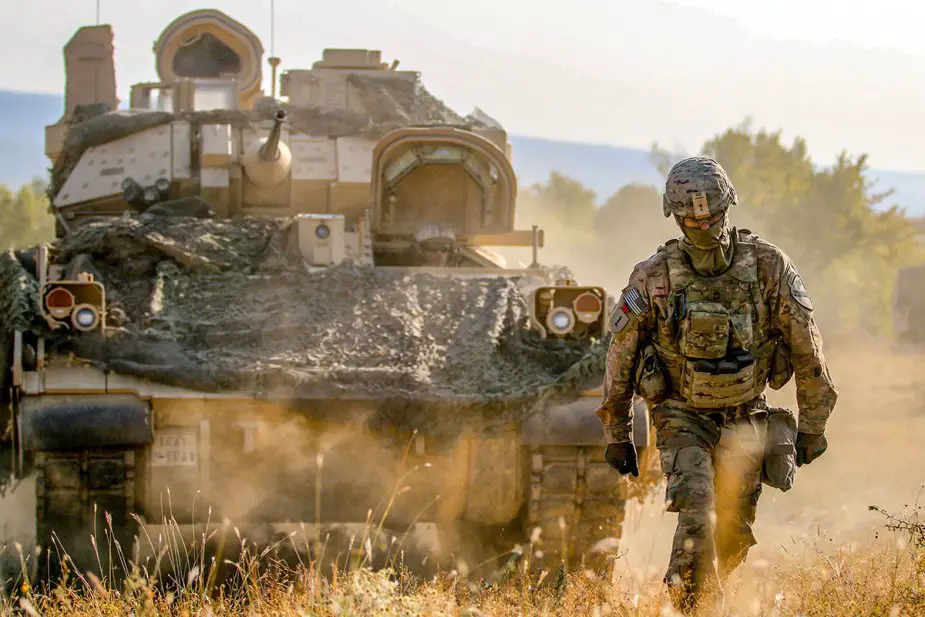US Army looking for Optionally-Manned Fighting Vehicle
A request for proposal for the Optionally-Manned Fighting Vehicle, or OMFV, has gone out to industry Friday, March 28, sent by the Next-Generation Combat Vehicle Cross-Functional Team. Devon L. Suits, Army News Service, details.

A soldier guides an M2A3 Bradley Fighting Vehicle during an exercise at Novo Selo Training Area, Bulgaria, Aug. 23, 2018. The Next-Generation Combat Vehicle Cross-Functional Team is slated to release a request for proposal for the Optionally-Manned Fighting Vehicle on March 29, 2019. The OMFV is considered to be a replacement for the Army's aging Bradley Fighting Vehicle (Photo Credit: US Army / Sgt. Jamar Marcel Pugh)
The OMFV is considered to be a replacement for the Army's aging Bradley Fighting Vehicle. "The next generation of combat vehicles will close the last tactical mile, giving our Soldiers a position of advantage," said Brig Gen. Ross Coffman, NGCV Cross-Functional Team director. "Our combat vehicles will have the ability to transition through those disruption zones with lethality and survivability ... [and] mobility, to be able to fight the enemy on our terms, and become victorious," Coffman said.
Lethality, survivability, and mobility continue to be at the forefront of the new OMFV program, Coffman said. However, the new system's requirements will be based on "attainable" technologies, rather than sinking countless amounts of money into an "unattainable" system. Adding excessive features to the new OMFV program is something the CFT is trying to avoid, he said. Further, the Army seeks the option to pack two OMFVs in one C-17 aircraft.
OMFV proposals will be due this fall, Coffman said. The Army plans to down select to two candidates.
In fiscal year 2020, the Army plans to start experimenting with a government-led Robotic Controlled Vehicles program, or RCV, Coffman said. "We're doing these experiments to test a series of hypotheses," he said. "I always emphasize it is an experiment. While I am an advocate, probably the No. 1 champion, that [believes] robots will change the way that we will fight combat in the future --- we owe it to the Army, taxpayers, and everyone to make sure that this is a prudent step forward." Currently, the Army is testing the RSV concept through the Synthetic Training Environment. These virtual experiments will inform the final vehicle requirements, Coffman said.
This fall, the CFT is slated to house a "robot rodeo," Coffman said. The team is asking industry partners to bring their robots so that the Army can determine, "what is in the realm of the possible."
Looking ahead to FY20, the Army's first experiment will focus on platoon-level operations, he said. During the scenario, Soldiers operating out of "two surrogate vehicles" will control a set of robots that bare a resemblance to the M113 armored personnel carrier. "The two surrogate vehicles will have four Soldiers in the back … and there'll be two Soldiers controlling one robot. One will be driving [the RCV] and the other will be controlling [the vehicle's] payload."
"We're going to test cognitive load on the Soldiers … and at what operational distances we are able to conduct operations. [The Army is focused on] the tactics, techniques, and procedures, and what we want to use moving forward," he added.
The second experiment will move the RSV to the company level and triple the number of robots and surrogate control vehicles. This phase will test offensive and defensive maneuver capabilities and it's slated for fiscal 2021. "During experiment two, we're asking industry to provide modified off-the-shelf robots," Coffman noted. "[The Army] will procure eight [industry] robots, then make a decision at the end of [testing]."
The final experiment is slated for fiscal 2023. The RSV will again operate at the company level, but this time, the vehicles will conduct a range of offensive, defensive, and combined arms breach maneuvers. "If I can put a robot in the direct line of fire of the enemy to determine their location, provided lethality, or breach an obstacle -- America's sons and daughters can be applied elsewhere on the battlefield," Coffman emphasized. "This will give a standoff from our enemy … increase our mobility, and provide efficiency to combatant commanders around the world."


























